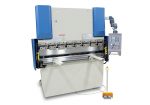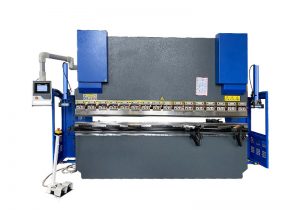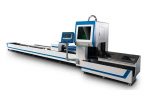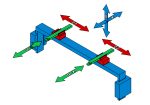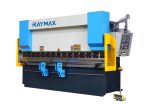Introduction
Maximizing efficiency and productivity in sheet metal processing is critical to any business. Hydraulic punching machines offer a powerful, efficient solution for achieving these goals. With the ability to quickly and accurately punch holes into sheet metal, hydraulic punching machines provide faster production times and increased precision. Additionally, they are cost-effective solutions that can help reduce downtime while still producing high-quality results. With the right setup and maintenance, hydraulic punching machines can be a great addition to any metal fabrication process.

Streamlining Sheet Metal Processing with Hydraulic Punching Machines
Streamlining sheet metal processing with hydraulic punching machines is a cost-effective solution for fabricators and manufacturers. These machines are designed to reduce the amount of time and labor needed for cutting, forming, and other metalworking tasks. Hydraulic punching machines can punch holes in thick steel plates at speeds of up to 500 strokes per minute with an accuracy of +/- 0.1mm. This makes them ideal for high-volume production runs where accuracy is critical.
The hydraulic punching machine operates by using a hydraulic cylinder to drive a ram that moves in a linear motion to punch out shapes from the sheet metal material placed on the die set mounted on the machine’s table. The cutting tool is guided by either manual or CNC (Computer Numerical Control) control systems, depending on the complexity of the job. Once punched out, these shapes can be formed into complex parts such as brackets or mounting plates without any additional machining steps required.

The use of hydraulic punching machines offers several advantages over traditional mechanical cutting processes such as sawing or shearing: they are much faster than these methods; they require less setup time; and they generate no hazardous waste due to their non-contact operation. In addition, they also produce parts with smoother edges than those produced by mechanical methods due to their higher accuracy and precision.
Hydraulic punching machines can be used for many different applications including automotive components, agricultural machinery parts, medical equipment components, electronic circuit boards, aircraft components, structural frames and enclosures, appliance housings and more – making them an invaluable asset for any manufacturing facility looking to increase efficiency while reducing costs associated with fabrication labor costs and materials waste.
Minimizing Costs and Enhancing Productivity Through Automated Hydraulic Punching
Automated hydraulic punching is an efficient and cost-effective method for businesses to enhance productivity and minimize costs. It is a process that uses advanced technology to punch holes into various materials with a high degree of accuracy, allowing companies to produce higher quality products in less time. This type of automated system has many advantages, including greater speed and accuracy, improved safety, reduced labor costs, and lower energy consumption.
The automated hydraulic punching process starts with the preparation of the material that needs to be punched. The material is placed on a platform before the automated machine begins its work. The machine then moves across the material while applying pressure in order to accurately punch holes through it. This process is highly precise and can be adjusted depending on the type of material being used. Automated hydraulic punching also allows for customized hole sizes and shapes as well as different types of punches such as countersinking or chamfering punches for creating beveled edges on metal parts or components.

One major benefit of using an automated hydraulic punching system is increased safety compared to manual methods since operators are not exposed to any dangerous machines or hazardous materials during operation. Additionally, because this system requires minimal human input, it eliminates potential errors due to human error while also decreasing labor costs associated with manual operations by reducing the need for multiple workers at one time. Furthermore, this type of machinery typically consumes less energy than manual processes which helps reduce operational costs further still by lowering energy bills associated with production activities.
Overall, businesses that incorporate automated hydraulic punching into their manufacturing processes can enjoy enhanced productivity along with significant cost savings due its efficiency and precision when compared to traditional methods such as manual punch presses or even laser cutting machines in some cases where intricate designs are needed in small spaces or large numbers are required quickly.. Automated hydraulic punching also provides greater safety for workers involved in production operations while reducing energy consumption levels which all contribute towards making this an attractive choice for businesses looking for ways to optimize their operations without sacrificing quality standards or increasing budgets significantly
Maximizing Accuracy and Quality with Hydraulic Punching Machines
The hydraulic punching machine is a versatile and powerful tool that can help to maximize accuracy and quality in a variety of industries. Hydraulic punching machines are used to punch holes in a wide range of materials, from thin sheet metal to thick steel plates. They are an essential part of any production process that requires precise cutting or forming.
Hydraulic punching machines provide several advantages over manual or mechanical systems. First, they are more accurate and precise than traditional methods, allowing for tight tolerances when creating complex shapes. Second, they can achieve higher levels of quality due to their ability to cut through thicker material with greater force than manual methods can generate. Finally, hydraulic machines are often faster and more efficient than manual processes due to the fact that they don’t require as much set-up time or need frequent calibration adjustments.
Hydraulic punching machines come in various sizes and configurations depending on the application requirements. Some machines feature an automated material handling system that feeds the material into the machine at precise speeds, while others feature manual controls for greater precision and control over the cutting process. The type of hydraulic system used will also affect performance – some use standard hydraulic fluid while others use special fluids designed specifically for high pressure applications like cutting thick steel plates. In addition, many models include features like multiple workstations or automated tool changing capabilities which help speed up production times even further by eliminating the need for frequent setup changes between jobs.
When it comes to maximizing accuracy and quality with hydraulic punching machines, there are several key factors that must be taken into consideration including material selection (thicker materials require more force), machine setup (ensuring all components are correctly aligned) and maintenance (regular inspections should be conducted). With proper care and attention these powerful tools can deliver consistent results time after time – helping companies maximize efficiency while reducing costs associated with inaccurate cuts or faulty products caused by inadequate tools or techniques.
Leveraging the Benefits of Automation for Increased Efficiency in Sheet Metal Processing
Automation in sheet metal processing has revolutionized the industry, allowing businesses to produce products faster and more efficiently than ever before. Leveraging the benefits of automation for increased efficiency can provide significant cost savings, improved quality control, and shorter lead times.
Automation eliminates the need for manual labor, reducing production costs and increasing throughput. Automated machines are more accurate than humans and can be programmed to repeat operations quickly and with precision, resulting in consistent product quality. Automated machines also reduce human error by reducing or eliminating manual data entry tasks such as measuring dimensions or entering codes into a computer system. This helps reduce waste and scrap, resulting in a better yield rate. Automation also reduces setup times for new jobs as well as cycle times for existing jobs by providing real-time feedback on production progress which can then be used to optimize processes further.
Leveraging automation can also help streamline inventory management by eliminating manual counting processes while providing greater visibility into material usage rates so that stock levels can be adjusted accordingly. Additionally, automated systems are often able to communicate with one another via digital networks which further increases operational efficiency by facilitating faster decision making across multiple departments within an organization.
Finally, automated systems are often equipped with sensors that allow them to detect changes in the environment such as temperature or humidity levels which allows operators to adjust their settings accordingly without wasting time manually adjusting each machine’s settings individually. This feature helps ensure optimal performance regardless of external factors and provides businesses with greater flexibility when it comes to meeting customer demands.
In summary, leveraging the benefits of automation for increased efficiency in sheet metal processing offers numerous advantages such as reduced costs due to fewer labor requirements; improved product quality due to greater accuracy; shorter lead times due to optimized setup processes; streamlined inventory management; faster decision making through digital communication networks; and increased flexibility through environmental sensors that automatically adjust settings according to external factors.
Adopting Best Practices for Maximum Performance from Hydraulic Punching Machines
The adoption of best practices for maximum performance from hydraulic punching machines is essential to ensure the successful operation of any industrial business. Hydraulic punching machines are used in a variety of industries and applications, from manufacturing to construction and fabrication. By implementing best practices for their use, businesses can benefit from improved productivity and efficiency.
First, it is important to keep the machine clean and properly lubricated at all times. This will reduce wear and tear on the machine as well as increase its life expectancy. Additionally, regular maintenance should be performed on hydraulic punching machines to ensure that all parts are functioning properly and safely. Businesses should also invest in quality components such as hoses, seals, valves, pumps, cylinders, filters and other parts which are designed specifically for their model of hydraulic punching machine.
Second, it is essential that businesses understand how to operate their hydraulic punching machines safely at all times. Employees must be trained in proper operating procedures such as turning off the power before cleaning or performing maintenance tasks on the machine or making sure that safety guards are in place while working with moving parts or sharp edges on metal sheets or other materials being cut by the machine’s punches. Additionally, businesses should implement a safety program which outlines proper procedures for using these types of machines so that workers are aware of any potential hazards associated with their use.
Thirdly, businesses should select an appropriate type of hydraulic punch for their needs based on its application requirements as well as the materials being punched by it such as metal sheets or aluminum extrusions etc., this will help maximize performance from these types of machinery while minimizing any risks associated with them during operation due to incorrect selection criteria when purchasing one.
Finally businesses should also consider investing in advanced features offered by some manufacturers which include automatic sheet-feeding systems integrated into some models which allow operators to punch without manually feeding each piece into position thereby increasing productivity levels considerably over manual operations where each piece has to be fed manually into position prior to punching taking place thus saving valuable time when working with large volumes of material needing punched quickly but accurately within tight tolerances demanded by modern industry today!
Identifying Ways to Optimize Production Times With Hydraulic Punching Machines
Optimizing production times with hydraulic punching machines is an important goal for any manufacturing business. Hydraulic punching machines are designed to quickly and efficiently cut a variety of materials into specific shapes. These machines can be used in many different types of industries, including automotive, aerospace, and medical device manufacturing. By optimizing production times with hydraulic punching machines, businesses can improve efficiency and reduce costs.
To optimize production times with hydraulic punching machines, there are several strategies that can be employed. The first step is to ensure that the machine is properly set up for the specific job at hand. This includes selecting the appropriate punch size and making sure that all components are properly aligned before beginning work. Properly configuring the machine will help ensure that it runs as efficiently as possible throughout the entire process.
Another way to optimize production times with hydraulic punching machines is by regularly performing maintenance on them. Regular maintenance will help keep them running smoothly and reduce downtime due to unexpected repairs or malfunctions. It’s also important to use high-quality punches that have been specifically designed for use in hydraulic punches; these punches are typically made from higher-grade materials and will stand up better against wear-and-tear over time than other punches would be able to withstand.
Finally, businesses should also invest in tools such as die sets or custom fixtures which can speed up the process of setting up a job on a hydraulic punch machine by allowing parts to be quickly loaded into place without having to manually adjust settings every time a new job is started. Additionally, investing in automated material handling systems such as robotic arms or conveyor belts can greatly reduce setup times by eliminating manual material handling operations altogether; this type of automation can significantly improve overall efficiency when it comes to working with hydraulic punch machines on large projects which require multiple setups over time due to changes in design or materials being used during the course of production.
By employing these strategies when using hydraulic punch machines, businesses can effectively optimize their production times while ensuring that they maintain their high standards for quality control throughout each project cycle from start to finish
Conclusion
In conclusion, maximizing efficiency with hydraulic punching machines for sheet metal processing is a smart business decision. These machines are fast, precise and require minimal maintenance. They reduce costs, improve safety and deliver consistent results. With their high-quality performance, they can help businesses meet their production goals more quickly and effectively. Investing in these machines is a wise move that will pay off in the long run.

